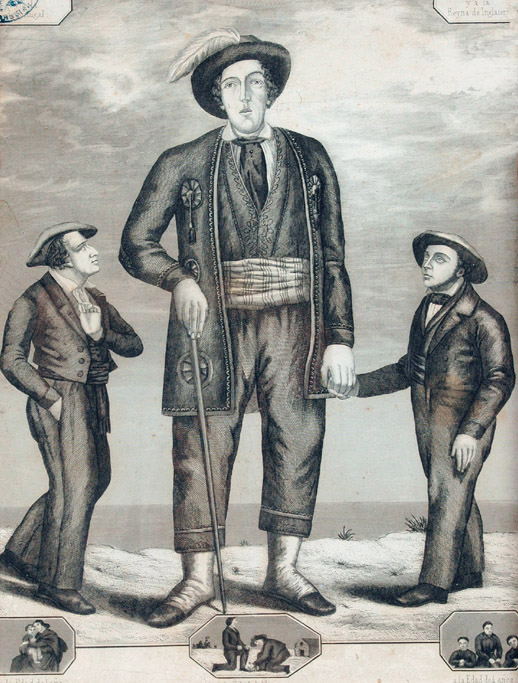
The recent release of the Basque film with this title, directed by Jon Garaño and Aitor Arregi, and starring, among others, Eneko Sagardoy as the Giant from Altzo, gives a nearly forgotten story a place in the limelight. What little has been said and written about his life comes from the same scarce sources, largely Serapio Múgica and Higinio Gandarias. The writer and Basque folklorist Iztueta, a contemporary of theirs, says he was known as the ‘Basque Giant’.
Altzo is a small locality in the region of Tolosa (Gipuzkoa) with two major population centres: Altzo Azpi (Lower Altzo) and Altzo Muño (Upper Altzo). Our man, Miguel Joaquín de Eleizegi, came into the world in 1818 at Ipintza Zarra Farmhouse in Altzo Azpi.
As it seems, he presented no special features at birth but grew to enormous proportions in adulthood, thus needing plenty of food and drink to satisfy his hunger and quench his thirst. He suffered from acromegaly, a disorder of the pituitary characterized by excessive production of growth hormone. Those who knew him credited him for being a truly good and exemplary man. He is said to have showed great skill in repairing carts and farm tools and mastered the art of building dry-stone walls.

The Giant from Altzo with his father and brother. Journal of the Royal Basque Society of the Friends of the Country, 1979.
His body measurements were chiselled on the wall of the portico at St Salvador’s Church in Altzo. He reached a height of 2.42 m and his maximum arm spam approximately equalled his body length. He was beardless and fairly thin, not exceeding 203 kg in weight. Compared to other big folk of his time, most of them with physical deformities, Joaquín was of a perfectly upright and well-proportioned stature.
Every time he travelled to Tolosa, he aroused great curiosity from the locals. With the intention of making money from it, he ventured to exhibit his physique in the company of a neighbour from Villabona. Later it would be his father who accompanied him in his wanderings. He gave his first performance in Bilbao, next Donostia and other places in Spain and abroad, although there is debate over the dates of such appearances. He was seen by Queen Elizabeth II of Spain, Queen Victoria of England, Maria of Portugal and King Louis Philippe I of France.
To publicly perform, he would be dressed as a Turk, or more frequently, in the uniform of a general of the Spanish army. In 1843 an agreement was signed by a company set up for the purpose and the giant himself and his family by which Miguel Joaquín was entitled to remuneration in return for public exposure during a year. As evidence of his religious convictions, it includes a clause stating: “… that he should be allowed to attend mass on holy days of obligation, wherever he would be”.
Having used up a large portion of his savings, and after he stopped exhibiting himself, he reportedly requested lifelong financial provision from the Council of Gipuzkoa, which he was denied. His physical suffering would then be compounded by prostration and no financial assistance whatsoever.
He died at 43 years of age in his birth house, the cause of his death remaining uncertain. His acromegaly is likely to have caused irreversible damage to his vascular and renal systems. Some ethnographers hold he might have died of pulmonary tuberculosis. His remains rest in the cemetery of Altzo.
Various objects of his personal use are preserved in San Telmo Museoa – St Telmo Museum in Donostia: a chair, the model of a 39-cm-long shoe, a pair of gloves, two top hats, a pencil portrait of him and his father…, which are a testament of his severe gigantism.
Segundo Oar-Arteta – Etniker Bizkaia – Etniker Euskalerria Groups
Translated by Jaione Bilbao – Language Department – Labayru Fundazioa